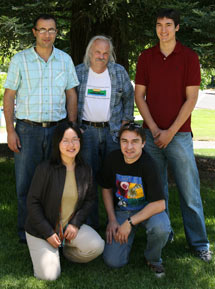BaBar scientists hunting for the light Higgs boson include: (clockwise from back left) Arafat Gabareen Mokhtar, Arthur Snyder, Erik Petigura, Yury Kolomensky, and Hojeong Kim. (Photo by Nicholas Bock.)
The BaBar collaboration submitted two papers to Physical Review Letters last month, both searching for hypothetical light-mass Higgs bosons, the particles suspected of giving objects their mass. While the Large Hadron Collider at CERN will search for a heavy-mass Higgs that lies outside the BaBar experiment's energy range, other theories predict another, lighter Higgs within BaBar's reach. Both papers found no evidence of a low-mass Higgs in the BaBar data set.
"While it would have been very exciting to find a low-mass Higgs, the BaBar results are still important for the particle physics community," says Yury Kolomensky of U.C. Berkeley and Lawrence Berkeley National Laboratory. "A negative result can rule out some Higgs theories, which is positive progress. If and when the Higgs is discovered, we will need to understand the underlying theory. Do we live in a world where a single Higgs boson is responsible for the generation of the mass of all particles, or is there more variety in nature?"
"The concept of mass is one of the most intuitive ideas in physics, since it is present in everyday human experience," writes Erik Petigura, a junior physics major at U.C. Berkeley. "Yet the fundamental nature of mass remains one of the great mysteries [of science]." Petigura's words open the first of the two journal articles, on which he is a collaborator.
Scientists believe that Higgs bosons cluster around other particles, giving them mass. Imagine a party where guests stand randomly distributed about the room. When the guest of honor arrives, the guests clump around her, giving her more inertia and making it harder for her to move once she starts to slow down. The Higgs bosons behave like these partygoers, surrounding particles and giving them mass. The Standard Model of particle physics predicts the existence of a particle like the Higgs boson, and has successfully described most known particle physics phenomena. Yet the Higgs boson, the last essential ingredient of the Standard Model, remains undiscovered.
Alternative theories exist, and are often based on new observations in astrophysics such as the properties of the mysterious dark matter. Scientists are drawn to them because they may be able to solve some of the unsatisfactory features in the Standard Model, such as the need to fine tune some parameters to make them match the values observed in nature. Some of these theories propose that several Higgs bosons may exist, with one of them having a lighter mass and lower energy than predicted by the Standard Model.
The BaBar experiment has produced vast numbers of particles called Upsilon mesons in different "resonances," or states: Y(2S), Y(3S), and Y(4S). According to some models, a light Higgs boson, A0, might be produced when the Y(2S) or Y(3S) mesons decay, emitting a photon. From there, A0 would also decay and scientists would search for products it leaves behind. Because so little is known about the theoretical A0, including its mass, it is important to search for it in as many ways as possible. One of the papers submitted by the BaBar collaboration last month details the search for the decay of a light-mass Higgs boson into a pair of muons, with research led by Petigura, Kolomensky and SLAC physicist Hojeong Kim. The second paper reports a related search for the Higgs decaying into tau-lepton pairs, with research led by SLAC physicists Arafat Gabareen Mokhtar and Arthur Snyder. Tau leptons are heavier than muons, so the two teams searched for the A0 in slightly different mass ranges.
The search involved painstaking separation of the potential signal candidates from millions of the unwanted background events, careful calibration of the detector properties and a scan of a wide range of A0 masses. After about a year of work by both groups, the results are in: no light Higgs.
Not yet, anyway. While the BaBar analysis was exhaustive, a light Higgs may still have slipped through a loophole. Nature may have made these decay processes barely visible with BaBar's data samples. The BaBar collaboration plans to improve the sensitivity of both the muon and tau analyses with additional data sets from different upsilon resonances. It's also possible that the light Higgs decays into something other than muons or taus. Additional searches are planned to look for Higgs decays into hadrons, another type of subatomic particle, as well as "invisible" decays of A0 that produce particles that do not interact with the detector. These processes still leave behind photons that the researchers can then search for.
If these efforts yield no discoveries, the theories that propose the light Higgs will be re-evaluated or discarded. The theoretical and astrophysical problems these theories attempted to solve will have to be addressed with new ideas. BaBar will then pass the torch to their colleagues at the Large Hadron Collider, which is expected to start again this October. In the Super B Factories, proposed to be built in Italy and Japan, would also increase dataset sizes by orders of magnitude, and could look for the hints of the Higgs in even more rare processes. The hunt for the Higgs continues…
SLAC Today, July 7, 2009







